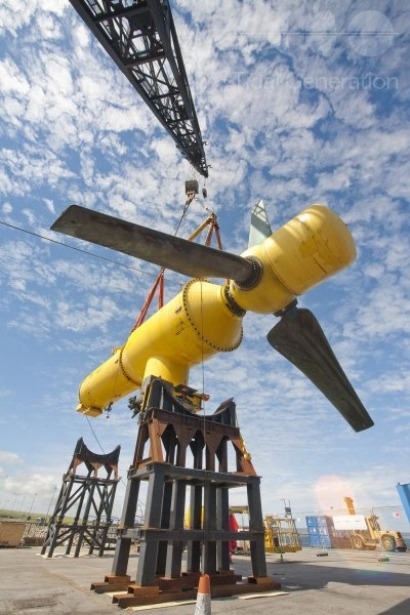
Rolls-Royce, better known for its luxury cars and aircraft engines, has achieved a significant milestone in the deployment of tidal energy technology with confirmation that its prototype tidal turbine, located subsea off the Orkney Islands (Scotland), has successfully generated and fed over 100 megawatt hours (MWh) of electrical power into the national grid.
“This is a significant milestone for the UK marine renewables industry. The UK is well-placed to exploit tidal stream energy resources and, if commercialised on a large scale, this technology could be an important part of the renewable energy mix we'll need in the future, and could create jobs and exports for the UK,” Neil Morgan, Head of Energy at the Technology Strategy Board.
Harnessing the reliable and predictable energy of tidal streams, the 500 kilowatt (kW) tidal turbine prototype was designed and built by Rolls-Royce wholly owned subsidiary Tidal Generation Limited.
Next step: bigger and more efficient
Robert Stevenson, Rolls-Royce, Vice-President - Power Ventures said: “Rolls-Royce has injected its world-class engineering expertise and incubation processes to deliver this innovative renewable energy project. Reaching the 100 megawatt hours milestone highlights the significant potential of cleaner, greener tidal power as part of a diversified UK energy mix. Having proven the capability of tidal energy, Rolls-Royce is well placed to meet any future demand with larger, more efficient technology on a commercial scale.”
Installed as part of the Deep-Gen III project, co-funded by the UK government-backed Technology Strategy Board, the Rolls-Royce prototype tidal turbine is currently deployed at the European Marine Energy Centre’s (EMEC) offshore test site off the Orkney Islands, Scotland. It is the first EMEC located project to both receive Renewable Obligation Certificates and to reach 100 MWh of supply to the grid.
The tidal unit’s three-bladed turbine is attached by a tripod to the seabed and can operate, fully submerged at water depth of 40 meters. Its innovative design allows the turbine to continually rotate to face the incoming tide at an optimal angle. In addition, the turbine unit is semi-buoyant and can be easily towed to and from the point of operation, minimising installation and maintenance costs by avoiding the need for specialist vessels.
As part of the Energy Technologies Institute funded ReDAPT (Reliable Data Acquisition Platform for Tidal) consortium project, Rolls-Royce is currently building a 1-MW tidal turbine demonstration unit that will be deployed in mid-2012 at EMEC in Orkney. The project will deliver detailed environmental and performance information never before achieved at this scale in real sea conditions.
Rolls-Royce is also working with a number of other developers in advancing demonstration arrays, systematic arrangements of turbines, which will lead to large scale commercial deployment. Last week, Robert Stevenson, Vice President of Power Ventures at Rolls-Royce told Bloomberg that his company was in talks with project developers and utilities to install further tidal energy turbines in Scottish and Irish waters.
The company has firm plans to roll out as much as 10 MW at the Inner Sound in Scotland as part of a project being built by Morgan Stanley, International Power Plc and turbine maker, Atlantis Resources. Delivery is expected to start in 2015.
Covering 7.5% of UK demand
As a reliable and predictable energy source, deep water tidal stream power generation could make a valuable contribution to meeting the electricity demands and carbon emissions reduction objectives of many industrialised nations, including the UK, Canada, Australia and the US. For example, Rolls-Royce estimates that its tidal technology could generate up to 30TWh (terawatt-hours) of UK electricity, equivalent to around 7.5 per cent of existing UK electricity needs or enough to power 3 million homes.
“The U.K. is already a world-leader in this exciting renewable sector. However, the long-term viability of tidal technology depends on it becoming competitive with other renewable energy sources. Continued investment and new partners are urgently needed to maintain momentum and bring the technology to scale,” commented Dr David Clarke, Chief Executive of the UK’s Energy Technologies Institute.
[Photo: Tidal Generation Limited's 500-kW tidal turbine prototype]
For additional information:

